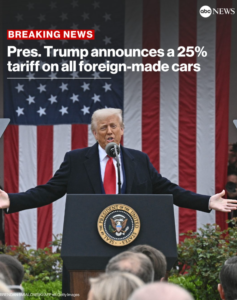On April 2, 2025, former President Donald Trump made headlines with the announcement of a sweeping new trade policy, declaring America’s longstanding trade deficits a “national emergency.” In a bold move that reignited debates over global trade and economic nationalism, Trump introduced broad tariffs on imports and unveiled what he called “Liberation Day”—a declaration of economic independence aimed at reasserting U.S. control over its trade destiny.
Trump’s plan includes a blanket 10% baseline tariff on all imported goods, effective April 5, with additional country-specific tariffs on nations with significant trade surpluses against the U.S. These include China (54% total), Japan (24%), India (26%), South Korea (25%), and the European Union (20%). The stated goal? To reduce the trade imbalance, revive domestic manufacturing, and punish what Trump called “decades of predatory practices by foreign powers.”
He justified the move by invoking the International Emergency Economic Powers Act (IEEPA), claiming the U.S. trade deficit—nearly $1 trillion in 2024—represented a threat to national security and long-term economic stability. “This is a declaration of economic independence,” Trump said during his address from the White House Rose Garden. “We will no longer sacrifice American workers, factories, and families on the altar of globalism.”
Critics quickly responded with concern. Economists warn that such aggressive tariffs could spark retaliatory measures from trading partners, increase consumer prices, and trigger inflation. Some analysts predict a potential global trade war reminiscent of the 2018-2019 disputes during Trump’s first term. Major business groups, including the U.S. Chamber of Commerce and National Retail Federation, issued statements cautioning against escalating trade tensions that could disrupt supply chains and hurt American consumers.
International allies reacted sharply. The European Union called the tariffs “a direct challenge to global trade norms,” while China warned of “grave consequences” and signaled countermeasures. Japan and South Korea expressed disappointment and hinted at World Trade Organization challenges. These reactions suggest that the world is bracing for a turbulent period of economic uncertainty.
Domestically, the move sparked political division. Some Republicans rallied behind Trump’s populist message of restoring American manufacturing, while Democrats and moderate conservatives questioned the legality of bypassing Congress to impose sweeping tariffs. Lawmakers are already proposing legislation to reassert congressional oversight over trade policies.
Despite the backlash, Trump remains undeterred. He argues that decades of trade deficits have hollowed out the American middle class and handed economic leverage to foreign nations. “This is about sovereignty,” he declared. “We’re finally standing up for the American worker.”
While Trump’s supporters hail the policy as a long-overdue correction to global trade imbalances, critics fear it may backfire economically and diplomatically. Whether this move will strengthen American industry or ignite economic instability remains to be seen, but one thing is clear: Trump’s tariffs have reopened a high-stakes debate about globalization, protectionism, and the future of the U.S. economy.
